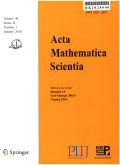- 钛学术文献服务平台 \
- 学术期刊 \
- 基础科学期刊 \
- 物理学期刊 \
- 数学物理学报(英文版)期刊 \
A BLOCK-CENTERED UPWIND APPROXIMATION OF THE SEMICONDUCTOR DEVICE PROBLEM ON A DYNAMICALLY CHANGING MESH
A BLOCK-CENTERED UPWIND APPROXIMATION OF THE SEMICONDUCTOR DEVICE PROBLEM ON A DYNAMICALLY CHANGING MESH
基本信息来源于合作网站,原文需代理用户跳转至来源网站获取
摘要:
The numerical simulation of a three-dimensional semiconductor device is a fundamental problem in information science.The mathematical model is defined by an initialboundary nonlinear system of four partial differential equations: an elliptic equation for electric potential,two convection-diffusion equations for electron concentration and hole concentration,and a heat conduction equation for temperature.The first equation is solved by the conservative block-centered method.The concentrations and temperature are computed by the block-centered upwind difference method on a changing mesh,where the block-centered method and upwind approximation are used to discretize the diffusion and convection,respectively.The computations on a changing mesh show very well the local special properties nearby the P-N junction.The upwind scheme is applied to approximate the convection,and numerical dispersion and nonphysical oscillation are avoided.The block-centered difference computes concentrations,temperature,and their adjoint vector functions simultaneously.The local conservation of mass,an important rule in the numerical simulation of a semiconductor device,is preserved during the computations.An optimal order convergence is obtained.Numerical examples are provided to show efficiency and application.

推荐文章
伊拉克 Block9 油田钻井提速技术研究
提速技术
Block9油田
钻井周期
机械钻速
井控
浅谈无线MESH网络技术
无线mesh网
宽带无线接入
无线多跳网
Age and geochemistry of Early Ordovician A-type granites in the Northeastern Songnen Block, NE China
Early Ordovician
A-type granite
Songnen and Xing'an blocks
Geodynamic setting
无线Mesh网络组网技术分析
WMN
组网技术
无线通信
内容分析
关键词云
关键词热度
相关文献总数
(/次)
(/年)
文献信息
| 篇名 | A BLOCK-CENTERED UPWIND APPROXIMATION OF THE SEMICONDUCTOR DEVICE PROBLEM ON A DYNAMICALLY CHANGING MESH | ||
| 来源期刊 | 数学物理学报(英文版) | 学科 | |
| 关键词 | |||
| 年,卷(期) | 2020,(5) | 所属期刊栏目 | |
| 研究方向 | 页码范围 | 1405-1428 | |
| 页数 | 24页 | 分类号 | |
| 字数 | 语种 | 英文 | |
| DOI | |||
五维指标
引文网络
引文网络
二级参考文献 (39)
共引文献 (3)
参考文献 (19)
节点文献
引证文献 (0)
同被引文献 (0)
二级引证文献 (0)
1963(1)
- 参考文献(0)
- 二级参考文献(1)
1964(4)
- 参考文献(1)
- 二级参考文献(3)
1982(2)
- 参考文献(0)
- 二级参考文献(2)
1983(1)
- 参考文献(0)
- 二级参考文献(1)
1985(3)
- 参考文献(1)
- 二级参考文献(2)
1986(1)
- 参考文献(0)
- 二级参考文献(1)
1988(2)
- 参考文献(1)
- 二级参考文献(1)
1989(1)
- 参考文献(0)
- 二级参考文献(1)
1990(1)
- 参考文献(1)
- 二级参考文献(0)
1991(3)
- 参考文献(1)
- 二级参考文献(2)
1992(2)
- 参考文献(0)
- 二级参考文献(2)
1993(4)
- 参考文献(1)
- 二级参考文献(3)
1994(1)
- 参考文献(0)
- 二级参考文献(1)
1995(4)
- 参考文献(1)
- 二级参考文献(3)
1996(4)
- 参考文献(1)
- 二级参考文献(3)
1997(2)
- 参考文献(2)
- 二级参考文献(0)
1998(2)
- 参考文献(2)
- 二级参考文献(0)
1999(1)
- 参考文献(1)
- 二级参考文献(0)
2000(4)
- 参考文献(2)
- 二级参考文献(2)
2005(2)
- 参考文献(0)
- 二级参考文献(2)
2006(1)
- 参考文献(0)
- 二级参考文献(1)
2008(2)
- 参考文献(0)
- 二级参考文献(2)
2009(3)
- 参考文献(1)
- 二级参考文献(2)
2011(1)
- 参考文献(0)
- 二级参考文献(1)
2012(3)
- 参考文献(2)
- 二级参考文献(1)
2013(2)
- 参考文献(0)
- 二级参考文献(2)
2017(1)
- 参考文献(1)
- 二级参考文献(0)
2020(0)
- 参考文献(0)
- 二级参考文献(0)
- 引证文献(0)
- 二级引证文献(0)
引文网络交叉学科
相关学者/机构
期刊影响力
数学物理学报(英文版)
主办单位:
中科院武汉物理与数学研究所
出版周期:
双月刊
ISSN:
0252-9602
CN:
42-1227/O
开本:
出版地:
武昌小洪山(武汉市71010信箱)
邮发代号:
创刊时间:
语种:
eng
出版文献量(篇)
2544
总下载数(次)
0
总被引数(次)
7016
期刊文献
相关文献
推荐文献
- 期刊分类
- 期刊(年)
- 期刊(期)
- 期刊推荐
力学
化学
地球物理学
地质学
基础科学综合
大学学报
天文学
天文学、地球科学
数学
气象学
海洋学
物理学
生物学
生物科学
自然地理学和测绘学
自然科学总论
自然科学理论与方法
资源科学
非线性科学与系统科学
数学物理学报(英文版)2022
数学物理学报(英文版)2021
数学物理学报(英文版)2020
数学物理学报(英文版)2019
数学物理学报(英文版)2018
数学物理学报(英文版)2017
数学物理学报(英文版)2016
数学物理学报(英文版)2015
数学物理学报(英文版)2014
数学物理学报(英文版)2013
数学物理学报(英文版)2012
数学物理学报(英文版)2011
数学物理学报(英文版)2010
数学物理学报(英文版)2009
数学物理学报(英文版)2008
数学物理学报(英文版)2007
数学物理学报(英文版)2006
数学物理学报(英文版)2005
数学物理学报(英文版)2004
数学物理学报(英文版)2003
数学物理学报(英文版)2002
数学物理学报(英文版)2001
数学物理学报(英文版)2000
数学物理学报(英文版)2020年第6期
数学物理学报(英文版)2020年第5期
数学物理学报(英文版)2020年第4期
数学物理学报(英文版)2020年第3期
数学物理学报(英文版)2020年第2期
数学物理学报(英文版)2020年第1期

 免费查重
免费查重










